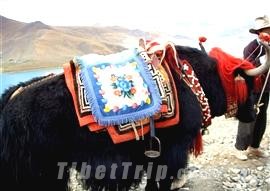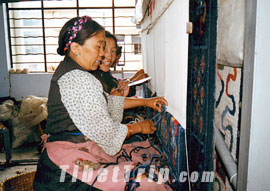
Using wool, cotton and sometimes yak hair, the hand-woven Tibetan carpets are damp-proof, durable and exceptional insulators. These characteristics make them a must for daily life in the cold, high altitude areas that make up Tibet. Different sized carpets are used in homes and monasteries as chair cushions, mattresses, tapestries, pillow cases, back cushions, kettle covers, numdah (an embroidered rug), and as decoration for pack-animals such as yak, mule, horse and donkey etc.
However, Tibetan carpets are not only articles for daily use; they are also works of art. Though the early Tibetan carpets are unpatterned and lacking in many colors, later carpets are highly decorated with
Thangkas , murals and patterns from inland areas for reference and designed many patterns of Tibetan style. Some frequently used traditional patterns are clouds, water, dragons, lions, phoenixes, red-crowned cranes, deer, flowers and bamboos, etc, which all express the good wishes of the weavers. Some Chinese characters for longevity, wealth, and good luck are also widely used. Nowadays, people also produce bigger carpets with patterns of the
Potala Palace ,
Mount Everest , and even the Great Wall etc.

The earliest dyes were all natural materials found in Tibet, such as wild plants, minerals and colored earth, which can be made up into different colors. Later some imported chemical dyes from neighboring countries, such as India and Nepal were used in dyeing wools. At present, some factories are using dyes imported from Switzerland. Comparing with chemical dyestuffs, the natural dyestuffs are more durable and of better quality but it is very time consuming to make them and the process is rather complicated, so fewer factories are now willing to use them and instead use the artificial dyes.
The unique and age old weaving method, the bright and never fading colors, the soft texture, the excellent insulation, never dropping hairs and the patterns of strong national and religious flavors, make Tibetan carpets highly prized and of great value. This might be why Tibetan carpets are named as one of the three best carpets in the world (the other two being Persian and Turkish) and are warmly welcomed by many countries in North America, Western Europe and Southeast Asia.
 Using wool, cotton and sometimes yak hair, the hand-woven Tibetan carpets are damp-proof, durable and exceptional insulators. These characteristics make them a must for daily life in the cold, high altitude areas that make up Tibet. Different sized carpets are used in homes and monasteries as chair cushions, mattresses, tapestries, pillow cases, back cushions, kettle covers, numdah (an embroidered rug), and as decoration for pack-animals such as yak, mule, horse and donkey etc.
However, Tibetan carpets are not only articles for daily use; they are also works of art. Though the early Tibetan carpets are unpatterned and lacking in many colors, later carpets are highly decorated with Thangkas , murals and patterns from inland areas for reference and designed many patterns of Tibetan style. Some frequently used traditional patterns are clouds, water, dragons, lions, phoenixes, red-crowned cranes, deer, flowers and bamboos, etc, which all express the good wishes of the weavers. Some Chinese characters for longevity, wealth, and good luck are also widely used. Nowadays, people also produce bigger carpets with patterns of the Potala Palace , Mount Everest , and even the Great Wall etc.
Using wool, cotton and sometimes yak hair, the hand-woven Tibetan carpets are damp-proof, durable and exceptional insulators. These characteristics make them a must for daily life in the cold, high altitude areas that make up Tibet. Different sized carpets are used in homes and monasteries as chair cushions, mattresses, tapestries, pillow cases, back cushions, kettle covers, numdah (an embroidered rug), and as decoration for pack-animals such as yak, mule, horse and donkey etc.
However, Tibetan carpets are not only articles for daily use; they are also works of art. Though the early Tibetan carpets are unpatterned and lacking in many colors, later carpets are highly decorated with Thangkas , murals and patterns from inland areas for reference and designed many patterns of Tibetan style. Some frequently used traditional patterns are clouds, water, dragons, lions, phoenixes, red-crowned cranes, deer, flowers and bamboos, etc, which all express the good wishes of the weavers. Some Chinese characters for longevity, wealth, and good luck are also widely used. Nowadays, people also produce bigger carpets with patterns of the Potala Palace , Mount Everest , and even the Great Wall etc. The earliest dyes were all natural materials found in Tibet, such as wild plants, minerals and colored earth, which can be made up into different colors. Later some imported chemical dyes from neighboring countries, such as India and Nepal were used in dyeing wools. At present, some factories are using dyes imported from Switzerland. Comparing with chemical dyestuffs, the natural dyestuffs are more durable and of better quality but it is very time consuming to make them and the process is rather complicated, so fewer factories are now willing to use them and instead use the artificial dyes.
The unique and age old weaving method, the bright and never fading colors, the soft texture, the excellent insulation, never dropping hairs and the patterns of strong national and religious flavors, make Tibetan carpets highly prized and of great value. This might be why Tibetan carpets are named as one of the three best carpets in the world (the other two being Persian and Turkish) and are warmly welcomed by many countries in North America, Western Europe and Southeast Asia.
The earliest dyes were all natural materials found in Tibet, such as wild plants, minerals and colored earth, which can be made up into different colors. Later some imported chemical dyes from neighboring countries, such as India and Nepal were used in dyeing wools. At present, some factories are using dyes imported from Switzerland. Comparing with chemical dyestuffs, the natural dyestuffs are more durable and of better quality but it is very time consuming to make them and the process is rather complicated, so fewer factories are now willing to use them and instead use the artificial dyes.
The unique and age old weaving method, the bright and never fading colors, the soft texture, the excellent insulation, never dropping hairs and the patterns of strong national and religious flavors, make Tibetan carpets highly prized and of great value. This might be why Tibetan carpets are named as one of the three best carpets in the world (the other two being Persian and Turkish) and are warmly welcomed by many countries in North America, Western Europe and Southeast Asia.








